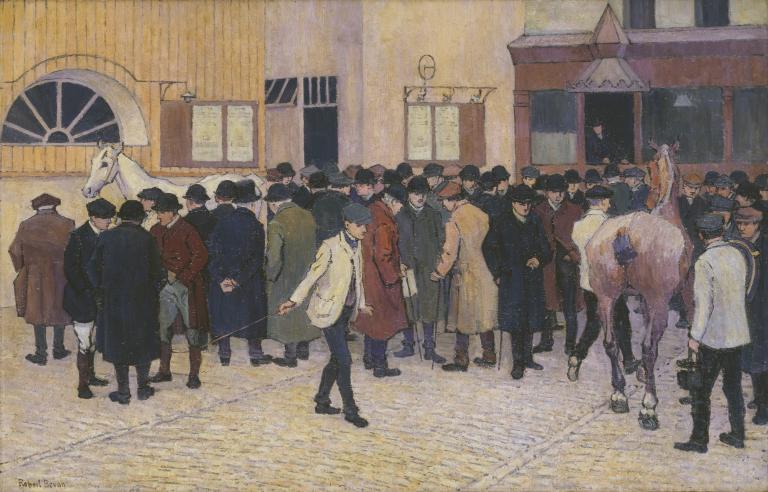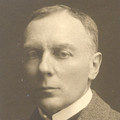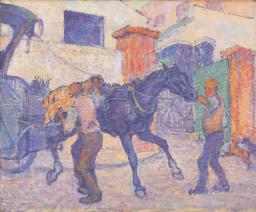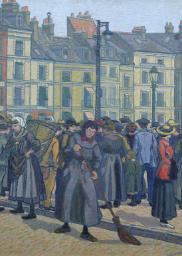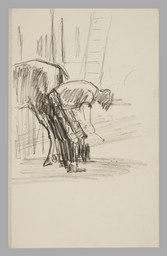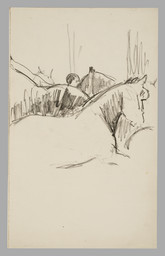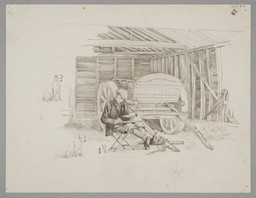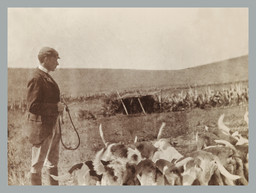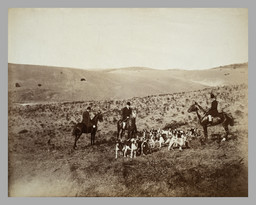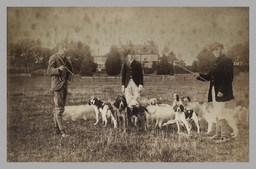Robert Bevan Horse Sale at the Barbican 1912
Robert Bevan,
Horse Sale at the Barbican
1912
The Royal City Horse and Carriage Repository located at 56 Barbican in Aldersgate was one of many horse markets in London. Bevan’s painting is made from the perspective of a viewer outside the ring of action: handlers lead a tawny horse through the crowd of men in bowler hats towards the booth of the auctioneer. Bevan’s horse-sale series overlapped with his cab-yard pictures. Both trades would succumb to the motor car by the end of the 1920s.
Robert Bevan 1865–1925
Horse Sale at the Barbican
1912
Oil paint on canvas
787 x 1219 mm
Presented by the Trustees of the Chantrey Bequest 1934
N04750
1912
Oil paint on canvas
787 x 1219 mm
Presented by the Trustees of the Chantrey Bequest 1934
N04750
Ownership history
Inherited by the artist’s widow, Stanislawa de Karlowska (1876–1952) from whom purchased by the Trustees of the Chantrey Bequest 1934; presented to Tate Gallery 1934.
Exhibition history
1912
The Third Exhibition of the Camden Town Group, Carfax Gallery, London, December 1912 (41, as ‘The Horse Mart’).
1913
Robert Polhill Bevan: Paintings and Drawings, Carfax Gallery, London, April 1913 (48).
1913–14
English Post-Impressionists, Cubists and Others, Brighton Art Gallery, December 1913–January 1914 (32, as ‘The Horse Mart’).
1914
The London Salon of the Allied Artists’ Association, Royal Albert Hall, London, July 1914 (685, £40).
1915
Exhibition of Works by Members of the Cumberland Market Group, Goupil Gallery, London, April–May 1915 (19, as ‘A Sale at the Barbican’).
1918
Eighth Exhibition of the London Group, Mansard Gallery, London, May–June 1918 (55).
1921
Exhibition of Pictures, Drawings, Sculpture and Applied Arts by Members of the Friday Club and Others, Mansard Gallery, London, April 1921 (130, as ‘Sale at the Barbican’).
1924
British Empire Exhibition, Palace of Arts, Wembley, London, April–October 1924 (Q11, as ‘Sale at the Barbican’, reproduced p.73).
1926
Robert Bevan: Memorial Exhibition, Goupil Gallery, London, February 1926 (143).
1926
Seventy-Third Exhibition of the New English Art Club, Spring Garden Gallery, London, April–May 1926 (6, as ‘Sale at the Barbican’).
1926
Royal Glasgow Institute of Fine Arts 1926.
1934
One Hundred and Sixty-Sixth Exhibition of the Royal Academy of Arts, Royal Academy, London, May–August 1934 (440, reproduced).
1949
Exhibition of the Chantrey Collection, Royal Academy, London, January–March 1949 (184).
1956–7
Robert Bevan 1865–1925, (Arts Council tour), Hatton Art Gallery, Newcastle, November 1956, Arts Council Gallery, London, December 1956–January 1957, Southampton Art Gallery, January–February 1957, Plymouth Art Gallery, February–March 1957, Leicester Museum and Art Gallery, March–April 1957 (15).
1965
Robert Bevan 1865–1925: Centenary Exhibition, P. & D. Colnaghi & Co. Ltd., London, March–April 1965 (32).
1965
Centenary Exhibition of Paintings, Drawings and Lithographs by Robert Bevan 1865–1925, Ashmolean Museum, Oxford, April–May 1965 (32).
2008
Modern Painters: The Camden Town Group, Tate Britain, London, February–May 2008 (22, reproduced).
2008–9
A Countryman in Town: Robert Bevan and the Cumberland Market Group, Southampton City Art Gallery, September–December 2008, Abbot Hall Art Gallery, Kendal, January–March 2009 (no number, reproduced pl.11).
References
1915
‘Art Exhibitions’, Evening Standard, 20 April 1915.
1915
Frank Rutter, ‘Round the Galleries’, Sunday Times, April 1915.
1915
Colour Magazine, vol.2, no.4, May 1915, reproduced.
1922
Gerrard Gwathmey, ‘A Group of English Art Rebels: Gilman, Ginner, Bevan and Others and What They Stand For’, Arts & Decoration, August 1922, reproduced p.253.
1926
Frank Rutter, ‘The Art of Robert Bevan’, Sunday Times, 7 February 1926.
1926
‘New English Art Club’, Morning Post, 13 April 1926.
1926
‘New English Art Club’, Queen, 21 April 1926.
1934
Royal Academy Illustrated, London 1934, reproduced p.119.
1951
Hesketh Hubbard, A Hundred Years of British Painting 1851–1951, London 1951, reproduced pl.83.
1956
Denys Sutton, ‘Painter of a Vanished Age’, Country Life, 20 December 1956, reproduced p.1453.
1958
F. Gordon Roe, ‘The Adventurous Robert Bevan: A Notable Painter of Horses and Horse Sales’, British Racehorse, July 1958, pp.117, 119, reproduced p.117.
1962
Synopsis, November 1962, pp.28–9, 30–1.
1964
Mary Chamot, Dennis Farr and Martin Butlin, Tate Gallery Catalogues: The Modern British Paintings, Drawings and Sculpture, vol.1, London 1964, p.55.
1965
R.A. Bevan, Robert Bevan 1865–1925: A Memoir by his Son, London 1965, pp.17, 25, 27, reproduced pl.43.
1971
Marjorie Lilly, Sickert: The Painter and His Circle, London 1971, reproduced pl.20.
1975
An Exhibition of the Bevan Gift of Paintings and Drawings by the Camden Town Group, exhibition catalogue, Camden Arts Centre, London 1975, [p.12].
1979
Wendy Baron, The Camden Town Group, London 1979, p.363.
1980
Wendy Baron and Malcolm Cormack, The Camden Town Group, exhibition catalogue, Yale Center for British Art, New Haven 1980, p.4.
1980
Simon Watney, English Post-Impressionism, London 1980, reproduced fig.49.
1981
Robert Bevan 1865–1925: Drawings and Watercolours, exhibition catalogue, Anthony d’Offay Gallery, London 1981, [p.25].
1987
Celina Fox, Londoners, London 1987, p.151, reproduced.
1988
Maureen Connet, ‘The Sketchbooks of Robert Bevan’, Apollo, no.313, March 1988, p.172.
1991
Bernadette Nelson, The Camden Town Group, exhibition catalogue, Ashmolean Museum, Oxford 1991, p.9.
1999
Frances Stenlake, From Cuckfield to Camden Town: The Story of Artist Robert Bevan, Cuckfield 1999, pp.41, 55, reproduced front cover, p.7.
2000
Wendy Baron, Perfect Moderns: A History of the Camden Town Group, Aldershot and Vermont 2000, p.163.
2008
Frances Stenlake, Robert Bevan: From Gauguin to Camden Town, London 2008, pp.97, 187–8, reproduced p.93.
Technique and condition
Horse Sale at the Barbican is painted in artists’ oil colours on primed stretched canvas. The cloth is one piece of plain open-weave linen secured to the stretcher with steel thumb tacks which remain in their original positions. Stretching appears to have been carried out by the artist. The stretcher consists of five pine members with slightly expanded joints. A paper label is adhered to the cross-bar and bears the handwritten inscription: ‘Robert P Bevan, 14 Adamson Road, Hampstead, Title “Sale at the Barbican”’. The off-white priming was applied to the stretched canvas and only covers the front face. If a sizing layer was applied it barely sealed the canvas which has allowed the fluid primer to penetrate through to the back. Saturated with priming, the canvas is stiff and has become brittle with age.
The painting covers the full extent of the stretched canvas face. The strong pattern of the design created by the emphatic, simplified drawing is balanced by an equally strong emphasis on the space of the enclosed yard. The initial design is drawn in dark blue paint (see Tate N05911), within which a complex agglomeration of vigorously worked, opaque colours is applied. The blue lines remain visible in the ragged troughs created between the applications of broken colour or are reinstated where they have been worked over or added into the wet colour where lines are used to describe details. The shapes’ local colours are gently modulated in hue and tone to indicate volume and shadow, thus the white of the horse and grooms’ jackets contains a subtle range of broken tints from the creams of the highlights to the darker tints of the mauve and green shadows. A sense of scattered light and surface texture is achieved through the overlaid fragmented colours and lively brushwork. The sense of recession is achieved by features such as the strong perspective of the cobbled yard, the foreshortening of the horse to the right, and the viewpoint which appears to be slightly above the milling crowd.
The painting has been given an uneven coat of varnish, which does not completely cover the surface. A restorer employed by Alex Reid & Lefevre to clean and varnish paintings by Bevan in preparation for exhibition in 1944 commented: ‘the paint is very thick and the varnish sinks quickly’.1 It is not known, in the case of this painting, whether the varnish was applied by the artist or by someone else after the work was sold. But its generally patchy appearance and the formation of pools and runs suggest that it was indeed difficult to apply due to characteristics of the paint surface.
Roy Perry
November 2003
Notes
How to cite
Roy Perry, 'Technique and Condition', November 2003, in Robert Upstone, ‘Horse Sale at the Barbican 1912 by Robert Bevan’, catalogue entry, May 2009, in Helena Bonett, Ysanne Holt, Jennifer Mundy (eds.), The Camden Town Group in Context, Tate Research Publication, May 2012, https://wwwEntry
Background
While still engaged in making pictures of cab-yards, Bevan extended his interest in the London working horse and began to visit the auctions where they were sold throughout the capital. His earliest recorded horse-auction picture is A Sale at Tattersall’s dating from 1911 (private collection),1 and he continued making sale-subject paintings into the 1920s. Although they overlapped with his cab-yard series, the horse-market pictures eventually replaced them, and became the central focus of his artistic interest. Bevan appears to have been rather pricked by observations, such as the critic Frank Rutter’s, that his interest in the cab-horse was motivated by some sort of nostalgic desire to record it because it was dying out (see Tate N05911). Bevan’s son recorded that ‘he told me many years later when I asked him why he had given up painting hansom-cabs for which he was perhaps best known in these years, he was anxious not to be accused of sentimentalising an almost vanished feature of London life’.2 This is significant, because it indicates that Bevan’s interest in such horse subjects was in their realism and in their being illustrations of everyday working life and metropolitan experience. In a sense, both the cab and auction subjects were a kind of documentation of a London trade somewhat in the tradition of The Cries of London, the famous series of pictures by Francis Wheatley (1747–1801) which appeared as prints between 1793 and 1796, or the sociological investigations contained in Henry Mayhew’s influential study London Labour and the London Poor (1851).
Bevan’s son, R.A. Bevan, recorded that:
he rather relished looking like a man who had to do more with horses and hounds than with canvas and paint. The brim of his bowler hat was flattened, his overcoats had little buttons at the back of the waist ... He always looked at home at Tattersall’s and other places where the horse took the centre of the stage. He looked neither like a bohemian nor like a business-man ... As children we were very conscious of the importance of the horse in our father’s life. We were often allowed to go with him when he was making drawings for cab-yard and horse-sale pictures. In earlier years he took us, of course, by horse-bus, and we sat on the front seats on top so that he could talk horses to the driver. At Tattersall’s and Aldridge’s, the Barbican and Ward’s Repository there would always be a word or two with dealers and with handlers – and even with the bearded, top-hatted auctioneer – who all seemed rather surprised that anyone should think they were worth drawing.3
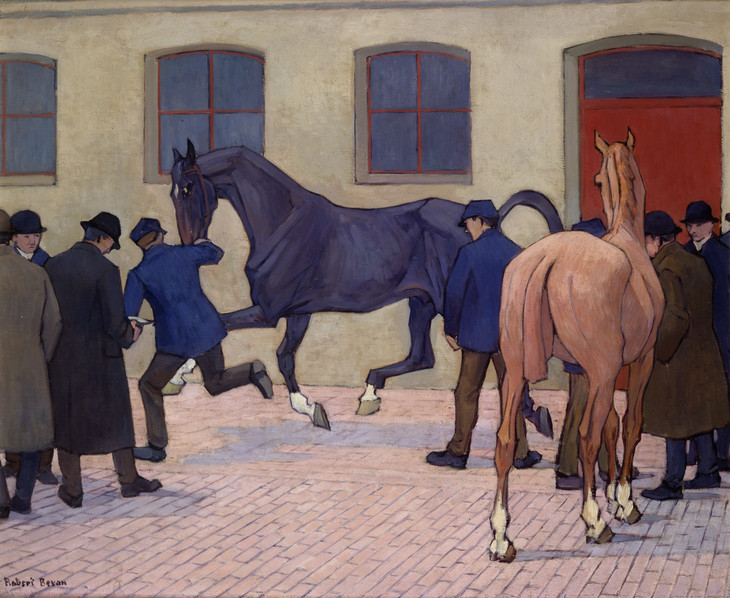
Robert Bevan 1865–1925
Showing at Tattersall's c.1919
Oil on canvas
580 x 710 mm
Ashmolean Museum, Oxford
Photo © Ashmolean Museum, Oxford
Fig.1
Robert Bevan
Showing at Tattersall's c.1919
Ashmolean Museum, Oxford
Photo © Ashmolean Museum, Oxford

Robert Bevan 1865–1925
Showing the Paces, Aldridge's c.1913–14
Oil paint on canvas
508 x 610 mm
Huddersfield Art Gallery
Photo © Huddersfield Art Gallery
Fig.2
Robert Bevan
Showing the Paces, Aldridge's c.1913–14
Huddersfield Art Gallery
Photo © Huddersfield Art Gallery
There were several horse sales in London and a distinct social hierarchy existed between them, deriving from the kind of horses in which they specialised. Bevan painted sales at Tattersall’s at Knightsbridge Green (fig.1), Aldridge’s in Upper St Martin’s Lane (fig.2), at the Barbican and Aldersgate in the City, and Ward’s Repository in Edgware Road. Tattersall’s was the most well to do, as it specialised in selling hunters and carriage-horses, but the others specialised in working horses for tradesmen and cab companies and attracted a very different social class of buyer or dealer. The Barbican horse sale started sometime in the eighteenth century and lasted some two hundred years. Located at 56 Barbican, in the Aldersgate district of the City, it operated under a variety of names at different times. When Bevan painted his picture it was called the Royal City Horse and Carriage Repository, but in 1919 it changed its name simply to the Barbican Repository. The company ceased to trade in 1926, and was formally dissolved by notice in the London Gazette of 16 December 1930.4 By the end of the 1920s motor transport had replaced horses to a large degree, and the continuation of the horse markets became economically untenable. Some horse-sale businesses survived by switching to selling motor cars.
Subject and composition
Bevan lived in Adamson Road NW3, so the Barbican was some distance away. He may have caught the bus, as his son recalls, or he would have been able to catch a direct train on the Metropolitan line of the Underground from Swiss Cottage, a short distance from his home, to the stop at Aldersgate, near where the horse sale took place. In Horse Sale at the Barbican Bevan shows a horse on the right being led to the front of the ‘ring’ ready to be bid on, while the one on the left is led away after having been sold. The figures dressed in white cloth or canvas jackets are handlers who work for the auction. The one on the right holds a harness and blinkers, presumably taken off the horse that is about to be sold. His colleague near the centre of the composition draws back a whip to encourage the horse’s swift passage through the ring. The auctioneer sits in the raised booth, leaning forward towards his audience, his authority embodied in his top hat. It is largely through their headgear that the audience reveals their social position and their significance as buyers at the auction. Today it is easy to underestimate the complex nuances of rank, prestige or respectability that a man’s hat suggested. Everybody wore hats, and the type chosen said a great deal about the individual or the occasion for which it was worn. Cloth caps were the usual, everyday attire of the worker, although they might also be the choice of dukes and gentry when in the country. The bowler hat, which is worn by the majority of those gathered in Bevan’s picture, indicated generally a higher social rank than the worker, perhaps the respectable clerk, or small businessman of the type who would attend such a sale. It was also associated with those connected with horses. Only one man wears a low-crowned top hat, evidently someone who is a larger or wealthier dealer or buyer. Other aspects of dress indicate the wearers’ proximity to their trade; the men wearing breeches, gaiters and boots are evidently clothed to ride horses, although such attire might also be associated with cab drivers. Much of the character of the figures is communicated through their poses. They have the posture of men who have been standing for some time. The sale might have started before dawn, as the presence of the electric lights in the background suggest. Beneath these are posters, with which the Barbican Repository advertised the types of horses to be sold. Bevan does not try to include any text, but taken in 1926, just before its closure, a photograph of the Barbican sale shows posters advertising ‘Ice Vanners’, ‘Cart Horses’ and ‘Draught Horses’. The photograph includes the crowd and auctioneer in a scene not unlike Bevan’s picture.5
Horse Sale at the Barbican was one of the largest pictures Bevan ever made, and has less of the contrasts or extremes of colour which characterised his earlier work. The colouring is subtle and modulated, and the paint has a dry and chalky character. An unfoliated sketchbook in the Ashmolean Museum, inscribed ‘to April 1915’ on the front cover, contains a large number of studies in pencil of single figures, figure groups, the auctioneer and his booth, and the progress of the horses being led into and out of the ring which relate to Horse Sale at the Barbican.6 The successive nature of the horse sketches, and the shifting poses of the crowd, indicate that these were evidently drawn on the spot. The sketchbook also contains a study for the overall composition of the oil which has the same distribution of figures and horses, but grouped much more tightly together. For the final oil composition Bevan has stretched out his design, spreading out the figures until they resemble something akin to a frieze. The extended format makes the drawing back of the central handler’s whip somewhat unrealistic. He is too far from the horse’s flanks for it to be effective, and in the original compact sketchbook design he is much closer. The painting was finally transferred from a large squared-up final drawing in crayon and watercolour measuring 369 x 559 mm, now in the Ashmolean Museum, identical in its composition to the finished oil.7
Exhibition and reception
At the third Camden Town Group exhibition Bevan exhibited The Horse Mart, with an asking price of 35 guineas, as against 20 guineas for another sale picture entitled Quiet with all Road Nuisances. It is likely that The Horse Mart was Horse Sale at the Barbican which, with its larger scale and complexity of composition, would justify a higher price. The picture went unsold. When Horse Sale at the Barbican was shown at the Cumberland Market Group exhibition at the Goupil Gallery in 1915, Frank Rutter wrote:
Mr. Robert Bevan, whose ‘horsy’ paintings have long delighted the connoisseur, is seen at his very best in his important painting ‘A Sale at the Barbican’ (19). Here is a finely decorative treatment of a scene from life, the figures simplified so as to tell in the mass, but not reduced to insignificance, the composition rhythmical and effective, and the colour brilliant and decoratively balanced. Mr. Bevan’s colour is highly personal, and may offend some by its sheer honesty, for it is his characteristic to avoid ambiguity and compromise. He has no use for neutral tints and whitey-black greys, but pursues the prismatic splendour of sunlight even into shadows, always preferring a definite blue to a bluish-grey, a definite mauve to an indefinite mauvish-grey, and so on. This gives extraordinary brilliance to his colour, but tends to make it ‘unreal’ in the sight of those, less gifted with colour perception, who see London in drabs and greys and biscuit tints.8
Bevan made a number of other pictures of the Barbican Repository. These include At the Barbican c.1913 (private collection),9 a crayon drawing of a horse being led out of the ring with the auctioneer’s booth viewed from the same position as in the Tate painting; The Horse Mart, Barbican no.1 1917–18 (Yale Center for British Art, New Haven),10 an oil of horses being led from the ring into the stables, of which Bevan published a lithograph in 1920 with the same title;11 Horse Dealers at the Barbican (Barbican No.2) 1921,12 another lithograph; and The Barbican c.1921 (Wakefield City Art Gallery),13 in crayon and watercolour showing one of the horses being trotted friskily round and which once belonged to Charles Ginner.
When Horse Sale at the Barbican was considered by the Trustees of the Chantrey Bequest, James Bolivar Manson, Director of the Tate Gallery, wrote to Bevan’s wife:
The picture passed through the Chantrey Recommending Committee with unanimous support. It has to appear before the President and Council [of the Royal Academy]. There’s not likely to be any difficulty now. Though I don’t like the frame.14
Robert Upstone
May 2009
Notes
Private collection, reproduced in British Drawings and Watercolours 1890–1940, exhibition catalogue, Anthony d’Offay Gallery, London 1982. This is likely to have been a design for a print that was never executed.
Related biographies
Related essays
Related catalogue entries
Related archive items
-
Photograph
-
Photograph
-
Photograph
Related film
-
A horse-drawn carriage and horse and cart pass by the Tate Gallery, London 1910© British Pathé
How to cite
Robert Upstone, ‘Horse Sale at the Barbican 1912 by Robert Bevan’, catalogue entry, May 2009, in Helena Bonett, Ysanne Holt, Jennifer Mundy (eds.), The Camden Town Group in Context, Tate Research Publication, May 2012, https://www

